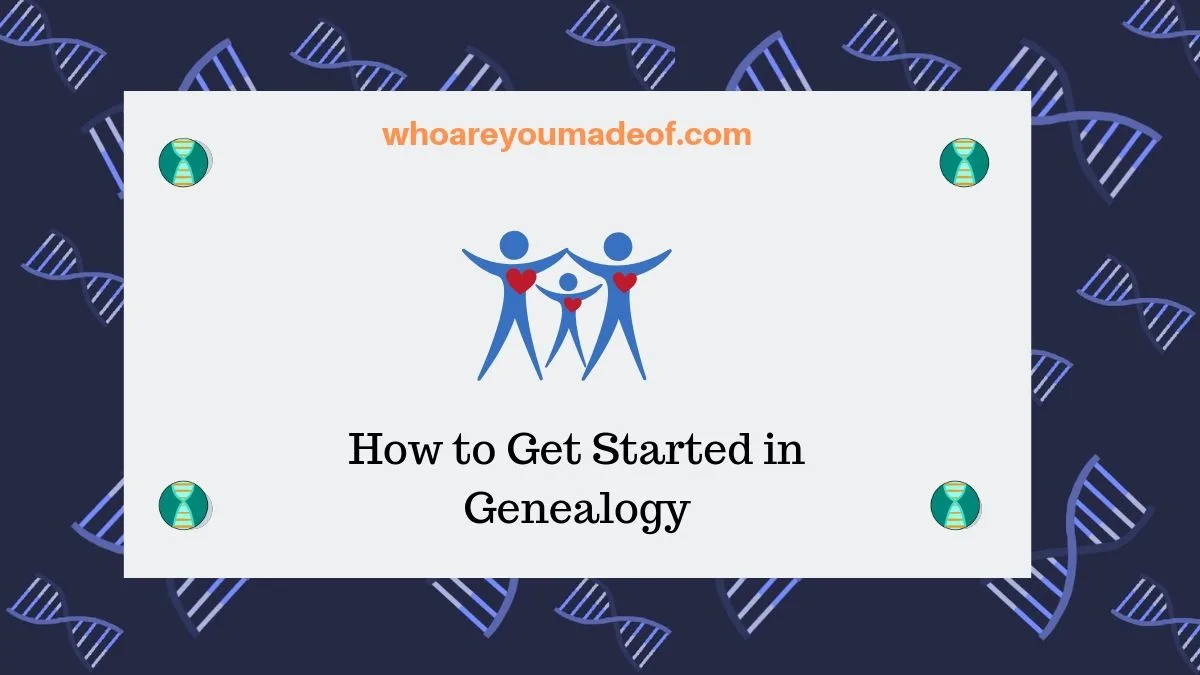Do you want to know how to get started in genealogy? In this post, you’ll find all of the steps that you need to take to start your family tree research, including how to use genealogy records to learn about your ancestors.
Many people feel overwhelmed with the idea of building a family tree, and they have more questions than they think they will ever be able to answer. Plus, there is the assumption that genealogy is only for retirees.

With all of the technology available to modern family tree researchers, genealogy is easier – and more fun – than ever. It can be as exciting as you want it to be.
Steps to get started in genealogy
The following are the steps you should take to get started researching genealogy. Further down in the post, you will find each step explained in more detail, along with helpful links and suggestions.
- Decide what you already know
- Start building your family tree online
- Plan what you would like to learn
- Consider doing a DNA test
- Talk to your older relatives
- Search US census records
- Learn about additional available records
- Decide which ancestors you are interested in learning more about
- Find relatives to be genealogy partners
If you ready the rest of this article and follow the above steps, you will be well on your way to being a seasoned genealogist. You may even become the person in your family that everyone knows can answer family history questions.
Decide what you already know about your family history
Most people know more than they think they do about their family’s history. For this reason, the best place to start your genealogy research is with yourself.
- Do you know the names of your parents and grandparents? Do you know the names of all of their siblings?
- Did you ever meet your great-grandparents? If so, what do you remember about them?
- Are there any stories or legends that have been passed down in your family? Are you interested in figuring out whether they are true?
- Do you know where your grandparents lived? Do you know if their family’s came from somewhere else?
- Which languages does your family speak? Are there stories about ancestors speaking different languages?
It’s okay if you don’t know the answer to each of these questions. Thinking about the questions, however, will help you realize what you already know. Plus, it will help you determine what you don’t know.
This is also the moment where you should try to locate any family histories or pedigrees that you may have been given over the years. Did you get a spiral-bound notebook with photographs and family tree information at a family reunion years ago?
Start building your family tree online
Now that you have taken stock of information that you already know or have access to, you should decide where you would like to put this information into family tree form. This is the best way to keep your research organized and on track.
Most people like to use online family tree building websites, though there is helpful software available for download if you would prefer to store it on your computer.
If you love the idea of building a family tree online, I would recommend Ancestry. It’s free, easy to use, and you can manage the privacy of your information with the click of a few buttons.
Read the following post about building a family tree on Ancestry:
Plan what you would like to learn about your family’s story
Now that you have already taken what you know and put it into family tree form, you can easily spot where you need to do more research. For example, maybe you know a lot about your dad’s side of the family but little about your maternal lines.
Before you continue in your genealogy journey, decide where you are going.
For example, when I got started in genealogy, I knew that I wanted to find out the place overseas where all of my ancestors where born. I am not interested in going back as far as I can, but instead making sure that I knew where all of my immigrant ancestors came from.
For me, this means that I might only have to find out where my Slovak great-great grandparent was born on one line, and on another, I might need to go all the way back to Ireland in 1812. Sometimes, I do get curious and want to explore just a little more on one line.
Everyone has different genealogy goals, and it’s up to you where you’d like to go in your research.
Consider doing a DNA test to help with family tree
At this point, you should consider doing a DNA test to see how DNA results can help you learn more about your family history. DNA testing can help solve family mysteries, as well as guide you in your future family tree research.
How can DNA testing help?
DNA results consist of two main elements: ethnicity estimates (ancestry estimates) and DNA matches. Ethnicity estimates can reveal unknown ancestry, and DNA matches can help you determine who your ancestors were.
Read more about my ultimate recommended DNA testing strategy here:
Talk to your older relatives about family history
Older relatives are an incredibly valuable source of information about your family history. Why is this the case?
Many of you grew up knowing your parents and grandparents, and sometimes even great-grandparents. Your parents, grandparents, and great-grandparents also may have known their parents, grandparents, and great-grandparents.
This means that by speaking with your grandmother who remembers her great-grandmother, you can have access to family memories going back as many as five or six generations.
For example, I have one grandparent still living. When I have spoken with her about family history, she can tell me stories about her great-grandmother who was born in 1861. This ancestor born before the Civil War was my great-great-great grandmother, and it is incredible that I can speak with someone who remembers what color her eyes were.
Talking with our older relatives is a great way to feel closer to our ancestors, as well as learn more about them.
If you have a family member who is from another country, or who is the child or grandchild of someone from another country, consider doing a “cultural heritage interview”:
Search US census records to find recent ancestors
Now that we are at the half-way point through my list of steps for getting started, you are ready to dive in to the fun part of genealogy. It’s time to explore US Federal Census records, an easy and useful type of historical record.
By this time, you probably know who your parents, grandparents, and great-grandparents are. You might even know who your ancestors are going back further on certain lines of your tree.
The most recent US Federal Census records available to the public are from 1940. However, we are all excited that the 1950 US Federal Census will be released to the public this year.
Learn about additional available genealogy records
Now that you have been introduced to a basic type of genealogy record, you might be interested to know that there are dozens more categories of records that can help you learn more about your ancestors. Each record that you locate can provide a clue about your ancestor’s life and help you understand where you should look for additional records.
The following article lists more than twenty types of genealogy records and gives suggestions for finding them (sometimes even for free!):
Every clue that you find on the documents that I listed above is important – nothing should be ignored.
For example, I have been researching my great-great grandmother, a Polish immigrant, for years – with little luck. She was married before she got married to my great-great grandfather, and since I have struggled to find records pertaining to her, I decided to focus on her first husband.
Yes, it’s often easier to find records about men than women.
I requested a copy of her first son’s birth certificate from the State of New Jersey. I am his great-grand niece, and not a direct descendant, but even so, I believed information on his birth certificate might help me in my quest.
His birth certificate included a “supplement” page with additional information, including a list of previous siblings born to his parents. On this list is a sister that I didn’t know about and the fact that the sister was born in Passaic, New Jersey in 1893.
Additionally, it says that the parents were married in Passaic, New Jersey around 1892.
This might seem like unimportant information. I’m not descended from the sister, and the marriage in Passaic was between my great-great grandmother and NOT my great-great grandfather.
How can learning about these events and people help me? Because of these new details, I now have new leads to investigate:
- I can try to locate a marriage record for the 1892 marriage in Passaic
- I can see if they were living in Passaic for the 1895 New Jersey Census
- I can see if I can locate a “paper trail” for the sister
- I can check to find other records in Passaic pertaining to either my ancestor or her husband
Decide which ancestors you are interested in learning more about
I’ll just say it – we have a LOT of ancestors. At the great-great-great-great grandfather level, we have 64 individual ancestors to trace.
At the 7th great-grandparent distance, we likely have more than 500 ancestors. Wow!
As much as we might like to think that we will be able to to devote the same time and energy to each ancestor, it isn’t realistic. Eventually, most of us choose our “favorites”.
I don’t mean that we don’t include all of our ancestors on our tree. Most genealogists try to form complete and accurate pedigrees.
Instead, I am suggesting that it’s okay if there are a few ancestors in your tree that really interest you. You may feel called to learn as much about them as possible.
If you follow all of the previous steps in this post, you probably know who these ancestors are. Deciding which ancestors pique your curiosity will help you form your research strategy, which we will discuss next.
Find relatives to be genealogy partners
A very helpful genealogy strategy is finding relatives who can informally partner with you on research. Most often, this relative is a second or third cousin who is also interested in your shared ancestor.
Plus, it’s lot of fun to have a relative who is just as interested in genealogy as you are. Many people have found that research partners make genealogy more exciting and fulfilling, since many times true friendships can develop between relatives who may have not previously known each other.

Conclusion
I hope that this post has helped you understand the steps to take to get started in genealogy and the tools to begin your journey. It is certain that you will find genealogy to be a fun and satisfying hobby, just as I have.
If you have any questions about something that you read in this post, or if you would like to share your own tips for starting genealogy research, I would love to hear from you in the discussion below.
Thanks for stopping by today!
